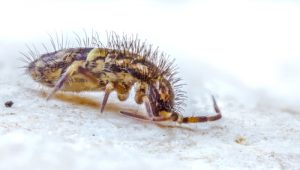Help For a Perpetual Springtail Problem
By Chris Williams on April 25, 2012.
Q. We have an ongoing problem with what I’ve been told are springtails. I find these tiny insects in the basement hallway around the back door. They seem to show up when the weather gets warm and hang around for most of the summer. This is the third year we’ve had this problem. Any suggestions?
A. The springtails could be breeding and surviving inside if you have a serious moisture problem around that back door area. The fact that the springtails are there for an extended time indicates that this is likely the case. Maybe there is wet, rotting wood around the doorframe or under the flooring. Or, there may be a plumbing leak, sweating pipes, or a floor drain causing moldy conditions. It’s also possible that the springtails are migrating in from outside. In this case, you need to check the tightness of that back door and install weather strips or a threshold if necessary. You also need to figure out why you have high moisture around the outside foundation of your home that is breeding springtails.
 Springtails (Collembola) are common insects outdoors in soil, mulch, under wet wood, and around swimming pools. Springtails are usually less than 1/16 inch long and come in all colors. They’re called springtails because of their ability to jump, using a forked spring called a “furcula” that is bent down underneath their abdomen. They’re so tiny that they often go unnoticed until they’ve built up to huge numbers. They can move indoors if conditions become too wet or too dry outside. They won’t survive long in the drier indoor air unless they find a location with high humidity. Although they do no damage, large numbers of jumping springtails can be disturbing.
Springtails (Collembola) are common insects outdoors in soil, mulch, under wet wood, and around swimming pools. Springtails are usually less than 1/16 inch long and come in all colors. They’re called springtails because of their ability to jump, using a forked spring called a “furcula” that is bent down underneath their abdomen. They’re so tiny that they often go unnoticed until they’ve built up to huge numbers. They can move indoors if conditions become too wet or too dry outside. They won’t survive long in the drier indoor air unless they find a location with high humidity. Although they do no damage, large numbers of jumping springtails can be disturbing.
The key to springtail control is to dry out the areas where they are found. Springtails need moisture and high humidity to survive. As the area dries out, springtails will die or leave. If the site can be dried out, pesticides are usually not necessary. In some situations, the high moisture is temporary (recent heavy rains) and the area will dry out on its own without intervention. But in most indoor springtail infestations, there is an ongoing moisture problem that is developing a thin (often unseen) layer of mold that springtails feed on. Repair plumbing, window, or roof leaks and fix condensation problems that are keeping areas wet.
In your case, you probably need to dry out both the inside and the outside. Simply vacuuming up the springtails around the door and hallway is a good first step. Then wash the area with a mild bleach solution to kill any mold, and let the site dry. See that rotting wood or any other moldy material is replaced or dried out. Turn on the house fan or place portable fans so that they dry out the site. Install a portable dehumidifier near the back door.
Outside, remove mulch and other damp materials around the foundation. Move firewood and debris piles away from the foundation. Check to see that water drains away from the foundation. Sometimes, in-ground sprinkler systems keep one wall or area around the house constantly damp and this can breed springtails.
If springtails are moving in from outside, an outside perimeter pesticide treatment may be necessary to stop the migration. Call us at Colonial and we’ll send out a technician right away. Insecticides break down quickly in moist sites, however, so springtail relief using insecticides is only temporary unless the moisture problem is corrected. Our trained technicians can also point out moisture problems around your home and advise you on how to eliminate moisture and dry out sites to eliminate springtails.